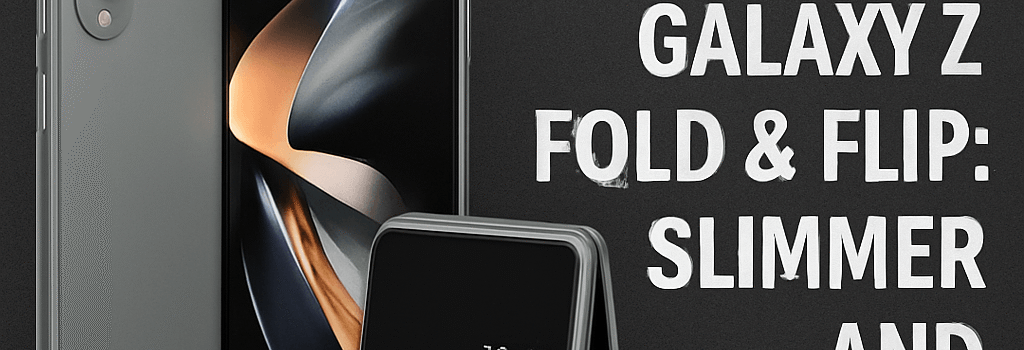Samsung’s 7th-Gen Galaxy Z Fold & Flip: Slimmer and Smarter

On July 25, Samsung’s newest foldables—the Galaxy Z Fold 7 and Z Flip 7 (plus an FE variant)—begin shipping worldwide. Representing the company’s most ambitious foldable redesign to date, these devices push the envelope in materials engineering, display technology, and on-device AI. Here’s an in-depth look at what’s new, how they compare to rivals, and what this means for the future of foldable smartphones.
Key Specifications at a Glance
- Galaxy Z Fold 7: 8.9 mm closed / 4.2 mm open, 255 g, 8.0″ AMOLED (1968×2184) @ 120 Hz, Snapdragon 8 Elite, 12–16 GB RAM, 200 MP main + 12 MP telephoto + 12 MP ultrawide cameras, 4,400 mAh battery, One UI 8 on Android 16, Armor Flex hinge, IPX8.
- Galaxy Z Flip 7: 6.5 mm open / 13.7 mm closed, 174 g, 6.9″ AMOLED (1080×2520) @ 120 Hz + 4.1″ cover display @ 120 Hz, Exynos 2500, 12 GB RAM, 50 MP main + 12 MP ultrawide, 3,700 mAh battery.
- Galaxy Z Flip 7 FE: 16.0 mm closed, 6.7″ internal + 3.4″ cover @ 60 Hz, Exynos 2400, 8 GB RAM, 50 MP main + 12 MP ultrawide, 3,700 mAh.
1. Design & Build: A New Chapter in Thinness
The headline improvement is the refined Armor Flex hinge—a redesigned multi-gear assembly with aerospace-grade stainless steel and a new polymer lubrication system. Combined with a 3rd-generation Ultra-Thin Glass (UTG), the Z Fold 7 achieves just 4.2 mm thickness unfolded, beating Google’s Pixel 9 Pro Fold (4.4 mm) and Oppo’s Find N3 (4.5 mm). Samsung’s precise tolerances reduce the bending radius to 0.05 mm, minimizing creasing.
Materials Advances
- Armor Flex hinge rated for 300,000 folds—50% more than the Z Fold 6.
- Improved UTG+: harder polymer coating for scratch resistance, now with 350 nits added peak brightness layer.
- IPX8 water resistance maintained through a sealed hinge and flex gasket design.
“Samsung’s new hinge technology looks to set a new durability bar for foldables,” says Dr. Lena Kim, materials scientist at TechInsight Research.
2. Display Evolution: Wider, Brighter, Faster
Both models feature Samsung’s latest Dynamic AMOLED 2X panels with LTPO backplanes for adaptive refresh rates from 1–120 Hz. The Z Fold 7 cover screen shifts to a 21:9 aspect, eliminating awkward letterboxing in apps. Peak brightness now hits 1,750 nits (HDR), up from 1,500 nits in Gen 6.
- Z Fold 7 Internal: 8.0″ (1968×2184) @ 120 Hz, 1,750 nits peak.
- Z Flip 7 Internal: 6.9″ (1080×2520) @ 120 Hz, 1,200 nits peak; Cover: 4.1″ @ 948×1048 @ 120 Hz.
3. Performance & Internals
The Snapdragon 8 Elite in the Z Fold 7 clocks up to 3.3 GHz on its Cortex-X4 core, pairing an NPU capable of 38 TOPS (trillion operations per second) with G77-based Adreno graphics. Benchmarks from early reviewers show a 15% uplift in multi-core CPU and 20% GPU gains over the Z Fold 6.
The Flip 7’s Exynos 2500 adopts TSMC’s 3 nm process, featuring a tri-cluster CPU (1×3.0 GHz Cortex-X4 + 3×2.7 GHz A720 + 4×2.0 GHz A520). While synthetic GPU scores trail the Adreno in folded flagships by 10%, real-world gaming remains smooth at 60 fps on high settings.
4. Camera System: Bridging the Gap to Flagship Flat Phones
For the first time on a Z Fold, Samsung integrates its 200 MP ISOCELL HP2 sensor with Tetra2pixel binning, capturing 12.5 MP images by default. Combined with a new computational Imaging Engine in Galaxy AI, low-light shots achieve ISO 12,800 native sensitivity.
- 12 MP 3× telephoto with OIS and Dual Pixel AF.
- 12 MP ultrawide with autofocus macro (focus range: 3–10 cm).
- 10 MP under-display selfie (folded) + 10 MP hole-punch (cover).
5. Battery & Charging
Despite the thinner chassis, Samsung retains a 4,400 mAh cell in the Z Fold 7 and 3,700 mAh in both Flip models. 25 W wired charging and 15 W wireless Qi charging remain, but optimized power management in One UI 8 extends screen-on time by up to 10%.
6. Software & Galaxy AI Enhancements
Launching on Android 16 with One UI 8, Samsung pledges seven major OS updates and additional security patches through 2030. New multi-window improvements bring a persistent Taskbar, snap layouts, and true drag-and-drop between apps.
On-device AI (Galaxy AI) now powers:
- Note Assist: real-time transcription and summarization of audio recordings.
- Portrait Duet: synchronizing depth maps from both screens for studio-quality selfies.
- Contextual Quick Answers: universal overlay that pulls data from emails, messages, and calendar using a 12 TOP on-device NPU.
“The on-device approach makes Galaxy AI faster and more privacy-centric than cloud-reliant competitors,” notes Camille Ortiz, mobile UX analyst at Gartner.
7. Durability & Real-World Testing
Third-party teardown specialists iFixit awarded the Z Fold 7 a repairability score of 6/10, citing modular internal assemblies but challenging front-panel removal. Meanwhile, SquareTrade drop tests show a 25% increase in hinge resilience versus Gen 6.
- Water resistance: IPX8 (1.5 m fresh water, 30 min).
- Scratch resistance: Corning Gorilla Glass Victus+ on cover displays.
- Hinge life test: 300,000 cycles under lab conditions.
8. Future of Foldables: Market Outlook
Foldable shipments are projected to surpass 100 million units by 2027 (Counterpoint Research). Samsung still commands 60% of the market, but rising competition from Google, Oppo, and Motorola is driving rapid innovation in form factor and price tiers.
With the Z Flip 7 FE priced at $899, Samsung finally undercuts Motorola’s Razr 2025 by $100, making foldables accessible for the first time to a broader audience. This new entry-level strategy could accelerate mainstream adoption.
Conclusion
Samsung’s 7th-generation Galaxy Z Fold 7 and Z Flip 7 represent a decisive leap in foldable design—thinner, lighter, and more powerful. While the premium $1,999 price tag remains steep, robust trade-in programs and the new $899 FE model offer flexible entry points. As software, AI, and hinge technology continue to improve, the era of practical foldables is finally upon us.